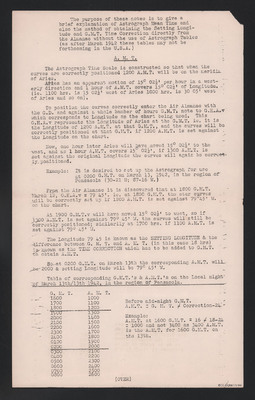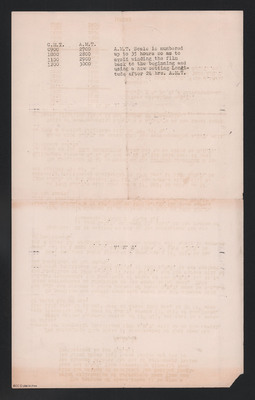Astrograph Mean Time Notes
Title
Astrograph Mean Time Notes
Description
Notes used in the training of a navigator.
Coverage
Language
Format
Two typewritten sheets
Publisher
Rights
This content is available under a CC BY-NC 4.0 International license (Creative Commons Attribution-NonCommercial 4.0). It has been published ‘as is’ and may contain inaccuracies or culturally inappropriate references that do not necessarily reflect the official policy or position of the University of Lincoln or the International Bomber Command Centre. For more information, visit https://creativecommons.org/licenses/by-nc/4.0/ and https://ibccdigitalarchive.lincoln.ac.uk/omeka/legal.
Contributor
Identifier
MJamesEC1385088-160907-040001, MJamesEC1385088-160907-040002
Transcription
The purpose of these notes is to give a brief explanation of Astrograph Mean Time and also the method of obtaining the Setting Longitude and G.M.T. Time Correction directly from the Almanac without the use of Astrograph Tables (as after March 1942 these tables may not be forthcoming in the U.S.A.)
[underlined] A. M. T. [/underlined]
The Astrograph Time Scale is constructed so that when the curves are correctly positioned 1200 A.M.T. will be on the meridian of Aries.
Aries has an apparent motion of 15° 02 1/2' per hour in a westerly direction and 1 hour of A.M.T. covers 15° 02 1/2' of Longitude, (ie. 1100 hrs. is 15 02 1/2' west of Aries 1000 hrs. is 30 05' west of Aries and so on).
To position the curves correctly enter the Air Almanac with the G.D. and against a whole hamber of hours G.M.T. note to G.H.A.v which corresponds to Longitude on the chart being used. This G.H.A.v represents the Longitude of Aries at the G.M.T. ie. it is the Longitude of 1200 A.M.T. at that G.M.T., and the curves will be correctly positioned at that G.M.T. if 1200 A.M.T. is set against the Longitude on the chart.
Now, one hour later Aries will have moved 15° 02 1/2' to the west, and as 1 hour A.M.T. covers 15 02 1/2', if 1300 A.M.T. is set against the original Longitude the curves will again be correctly positioned.
Example: It is desired to set up the Astrograph for use at 0200 G.M.T. on March 13, 1942, in the region of Pensacola (30-21 N; 87-16 W.)
From the Air Almanac it is discovered that at 1800 G.M.T. March 12, G.H.A.v = 79 45'. ie. at 1800 G.M.T. the star curves will be correctly set up if 1200 A.M.T. is set against 79° 45' W. on the chart.
At 1900 G.M.T.v will have moved 15° 02 1/2' to west, so if 1300 A.M.T. is set against 79° 45' W. the curves will still be correctly positioned; similarily [sic] at 1700 hrs. if 1100 A.M.T. is set against 79° 45' W.
The Longitude 79 45 is know as the SETTING LONGITUDE & the difference between G.M.T. and A.M.T. (in this case 18 hrs) is known as the TIME CORRECTION which has to be added to G.M.T. to obtain A.M.T.
So at 0200 G.M.T. on March 13th the corresponding A.M.T. will be 2000 & setting Longitude will be 79° 45' W.
Table of corresponding G.M.T.'s & A.M.T.'s on the Local night of March 13th/13th [sic] 1942, in the region of Pensacola.
[a] G.M.T. [b[ A.M.T.
[a] 1600 [b] 1000
[a] 1700 [b] 1100
[a] 1800 [b] 1200
Before mid-might G.M.T. A.M.T. = G.M.T. / Correction-24
[a] 1900 [b] 1300
[a] 2000 [b] 1400
[a] 2100 [b] 1500
[a] 2200 [b] 1600
[a] 2300 [b] 1700
[a] 2400 [b] 1800
[a] 0100 [b] 1900
[a] 0200 [b] 2000
Example: A.M.T. at 1600 G.M.T. = 16 /18-24 = 1000 and not 3400 as 3400 A.M.T. is the A.M.T. for 1600 G.M.T. on the 13th.
[a] 0300 [b] 2100
[a] 0400 [b] 2200
[a] 0500 [b] 2300
[a] 0600 [b] 2400
[a] 0700 [b] 2500
[a] 0800 [b] 2600
(OVER)
[page break]
[a] G.M.G. [b] A.M.T.
[a] 0900 [b] 2700
[a] 1000 [b] 2800
[a] 1100 [b] 2900
[a] 1200 [b] 3000
A.M.T. Scale is numbered up to 35 hours so as to avoid winding the film back to the beginning and using a new setting Longitude after 24 hrs. A.M.T.
[underlined] A. M. T. [/underlined]
The Astrograph Time Scale is constructed so that when the curves are correctly positioned 1200 A.M.T. will be on the meridian of Aries.
Aries has an apparent motion of 15° 02 1/2' per hour in a westerly direction and 1 hour of A.M.T. covers 15° 02 1/2' of Longitude, (ie. 1100 hrs. is 15 02 1/2' west of Aries 1000 hrs. is 30 05' west of Aries and so on).
To position the curves correctly enter the Air Almanac with the G.D. and against a whole hamber of hours G.M.T. note to G.H.A.v which corresponds to Longitude on the chart being used. This G.H.A.v represents the Longitude of Aries at the G.M.T. ie. it is the Longitude of 1200 A.M.T. at that G.M.T., and the curves will be correctly positioned at that G.M.T. if 1200 A.M.T. is set against the Longitude on the chart.
Now, one hour later Aries will have moved 15° 02 1/2' to the west, and as 1 hour A.M.T. covers 15 02 1/2', if 1300 A.M.T. is set against the original Longitude the curves will again be correctly positioned.
Example: It is desired to set up the Astrograph for use at 0200 G.M.T. on March 13, 1942, in the region of Pensacola (30-21 N; 87-16 W.)
From the Air Almanac it is discovered that at 1800 G.M.T. March 12, G.H.A.v = 79 45'. ie. at 1800 G.M.T. the star curves will be correctly set up if 1200 A.M.T. is set against 79° 45' W. on the chart.
At 1900 G.M.T.v will have moved 15° 02 1/2' to west, so if 1300 A.M.T. is set against 79° 45' W. the curves will still be correctly positioned; similarily [sic] at 1700 hrs. if 1100 A.M.T. is set against 79° 45' W.
The Longitude 79 45 is know as the SETTING LONGITUDE & the difference between G.M.T. and A.M.T. (in this case 18 hrs) is known as the TIME CORRECTION which has to be added to G.M.T. to obtain A.M.T.
So at 0200 G.M.T. on March 13th the corresponding A.M.T. will be 2000 & setting Longitude will be 79° 45' W.
Table of corresponding G.M.T.'s & A.M.T.'s on the Local night of March 13th/13th [sic] 1942, in the region of Pensacola.
[a] G.M.T. [b[ A.M.T.
[a] 1600 [b] 1000
[a] 1700 [b] 1100
[a] 1800 [b] 1200
Before mid-might G.M.T. A.M.T. = G.M.T. / Correction-24
[a] 1900 [b] 1300
[a] 2000 [b] 1400
[a] 2100 [b] 1500
[a] 2200 [b] 1600
[a] 2300 [b] 1700
[a] 2400 [b] 1800
[a] 0100 [b] 1900
[a] 0200 [b] 2000
Example: A.M.T. at 1600 G.M.T. = 16 /18-24 = 1000 and not 3400 as 3400 A.M.T. is the A.M.T. for 1600 G.M.T. on the 13th.
[a] 0300 [b] 2100
[a] 0400 [b] 2200
[a] 0500 [b] 2300
[a] 0600 [b] 2400
[a] 0700 [b] 2500
[a] 0800 [b] 2600
(OVER)
[page break]
[a] G.M.G. [b] A.M.T.
[a] 0900 [b] 2700
[a] 1000 [b] 2800
[a] 1100 [b] 2900
[a] 1200 [b] 3000
A.M.T. Scale is numbered up to 35 hours so as to avoid winding the film back to the beginning and using a new setting Longitude after 24 hrs. A.M.T.
Collection
Citation
“Astrograph Mean Time Notes,” IBCC Digital Archive, accessed November 15, 2024, https://ibccdigitalarchive.lincoln.ac.uk/omeka/collections/document/34028.
Item Relations
This item has no relations.


